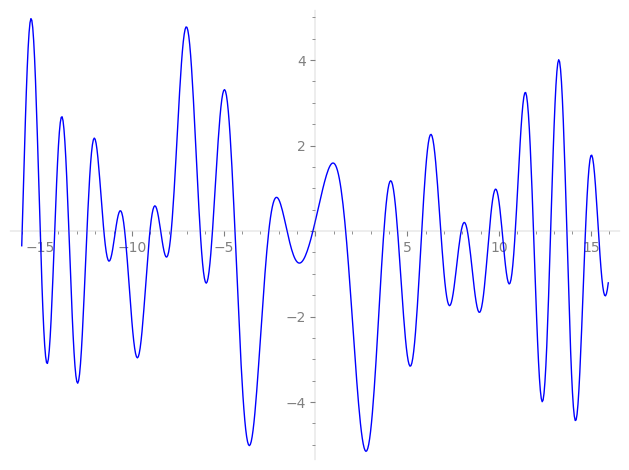| L(s) = 1 | + (−1.73 − i)2-s + (−0.866 − 1.5i)3-s + 3.46i·6-s + (6.06 + 3.5i)7-s + 8i·8-s + (−1.5 + 2.59i)9-s + (−5 − 8.66i)11-s + 12.1·13-s + (−7 − 12.1i)14-s + (8 − 13.8i)16-s + (3.46 + 6i)17-s + (5.19 − 3i)18-s + (−28.5 − 16.4i)19-s − 12.1i·21-s + 20i·22-s + (−34.6 − 20i)23-s + ⋯ |
| L(s) = 1 | + (−0.866 − 0.5i)2-s + (−0.288 − 0.5i)3-s + 0.577i·6-s + (0.866 + 0.5i)7-s + i·8-s + (−0.166 + 0.288i)9-s + (−0.454 − 0.787i)11-s + 0.932·13-s + (−0.5 − 0.866i)14-s + (0.5 − 0.866i)16-s + (0.203 + 0.352i)17-s + (0.288 − 0.166i)18-s + (−1.5 − 0.866i)19-s − 0.577i·21-s + 0.909i·22-s + (−1.50 − 0.869i)23-s + ⋯ |
\[\begin{aligned}\Lambda(s)=\mathstrut & 525 ^{s/2} \, \Gamma_{\C}(s) \, L(s)\cr =\mathstrut & (-0.758 - 0.652i)\, \overline{\Lambda}(3-s) \end{aligned}\]
\[\begin{aligned}\Lambda(s)=\mathstrut & 525 ^{s/2} \, \Gamma_{\C}(s+1) \, L(s)\cr =\mathstrut & (-0.758 - 0.652i)\, \overline{\Lambda}(1-s) \end{aligned}\]
Particular Values
| \(L(\frac{3}{2})\) |
\(\approx\) |
\(0.2467346429\) |
| \(L(\frac12)\) |
\(\approx\) |
\(0.2467346429\) |
| \(L(2)\) |
|
not available |
| \(L(1)\) |
|
not available |
\(L(s) = \displaystyle \prod_{p} F_p(p^{-s})^{-1} \)
| $p$ | $F_p(T)$ |
|---|
| bad | 3 | \( 1 + (0.866 + 1.5i)T \) |
| 5 | \( 1 \) |
| 7 | \( 1 + (-6.06 - 3.5i)T \) |
| good | 2 | \( 1 + (1.73 + i)T + (2 + 3.46i)T^{2} \) |
| 11 | \( 1 + (5 + 8.66i)T + (-60.5 + 104. i)T^{2} \) |
| 13 | \( 1 - 12.1T + 169T^{2} \) |
| 17 | \( 1 + (-3.46 - 6i)T + (-144.5 + 250. i)T^{2} \) |
| 19 | \( 1 + (28.5 + 16.4i)T + (180.5 + 312. i)T^{2} \) |
| 23 | \( 1 + (34.6 + 20i)T + (264.5 + 458. i)T^{2} \) |
| 29 | \( 1 + 16T + 841T^{2} \) |
| 31 | \( 1 + (-4.5 + 2.59i)T + (480.5 - 832. i)T^{2} \) |
| 37 | \( 1 + (-4.33 - 2.5i)T + (684.5 + 1.18e3i)T^{2} \) |
| 41 | \( 1 + 24.2iT - 1.68e3T^{2} \) |
| 43 | \( 1 + 19iT - 1.84e3T^{2} \) |
| 47 | \( 1 + (25.9 - 45i)T + (-1.10e3 - 1.91e3i)T^{2} \) |
| 53 | \( 1 + (27.7 - 16i)T + (1.40e3 - 2.43e3i)T^{2} \) |
| 59 | \( 1 + (36 - 20.7i)T + (1.74e3 - 3.01e3i)T^{2} \) |
| 61 | \( 1 + (-18 - 10.3i)T + (1.86e3 + 3.22e3i)T^{2} \) |
| 67 | \( 1 + (51.0 - 29.5i)T + (2.24e3 - 3.88e3i)T^{2} \) |
| 71 | \( 1 + 26T + 5.04e3T^{2} \) |
| 73 | \( 1 + (9.52 + 16.5i)T + (-2.66e3 + 4.61e3i)T^{2} \) |
| 79 | \( 1 + (-23.5 + 40.7i)T + (-3.12e3 - 5.40e3i)T^{2} \) |
| 83 | \( 1 + 24.2T + 6.88e3T^{2} \) |
| 89 | \( 1 + (102 + 58.8i)T + (3.96e3 + 6.85e3i)T^{2} \) |
| 97 | \( 1 - 48.4T + 9.40e3T^{2} \) |
| show more | |
| show less | |
\(L(s) = \displaystyle\prod_p \ \prod_{j=1}^{2} (1 - \alpha_{j,p}\, p^{-s})^{-1}\)
Imaginary part of the first few zeros on the critical line
−10.39196374753360042297763276224, −9.014680490178685158867710559623, −8.430701803282530739168008634239, −7.85651237907701530503737486569, −6.27784537620264540193805906237, −5.60925210954657575459366526399, −4.38497039768317474745048237331, −2.54188042159885225125456155314, −1.54613613700485029053241437764, −0.13828042778945180405560059305,
1.64589875891928801117574003327, 3.72863635681364083389026851569, 4.47511321823972356152147722499, 5.78836466210515530171752136969, 6.82621748546281353545584150800, 7.937457803656994551219212540477, 8.275778489175488831886411658648, 9.469806580035018541584180136156, 10.16837262035845048363314321840, 10.88512365923016995296996461175

